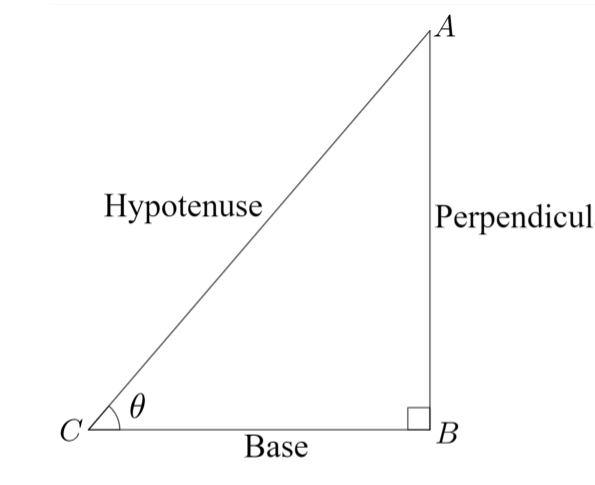
If \[x\sin {45^ \circ }{\cos ^2}{60^ \circ } = \dfrac{{{{\tan }^2}{{60}^ \circ }\cos ec{{30}^ \circ }}}{{\sec {{45}^ \circ }{{\cot }^2}{{30}^ \circ }}}\] then \[x = \]
A.\[2\]
B.\[4\]
C.\[8\]
D.\[16\]
Answer
488.7k+ views
Hint: Trigonometric functions are also known as Circular Functions can be simply defined as the functions of an angle of a triangle. It means that the relationship between the angles and sides of a triangle are given by these trig functions. The basic trigonometric functions are sine, cosine, tangent, cotangent, secant and cosecant.
Complete step-by-step answer:
The angles of sine, cosine, and tangent are the primary classification of functions of trigonometry. And the three functions which are cotangent, secant and cosecant can be derived from the primary functions. Basically, the other three functions are often used as compared to the primary trigonometric functions.

Sine: \[\sin \theta = \dfrac{{perpendicular}}{{hypotenuse}}\]
Cosine: \[\cos \theta = \dfrac{{base}}{{hypotenuse}}\]
Tangent: \[\cos \theta = \dfrac{{perpendicular}}{{base}}\]
The Secant, the cosecant (csc) and the cotangent are the three additional functions which are derived from the primary functions of sine, cos, and tan. The reciprocal of the sine, the cos, and the tan are the cosecant (csc), the secant (sec), and the cotangent (cot) respectively.
Inverse trigonometric functions are used to obtain an angle from any of the angle’s trigonometric ratios. Basically, inverses of the sine, cosine, tangent, cotangent, secant, and cosecant functions are represented as arcsin, arccosine, arctangent, arc cotangent, arc secant, and arc cosecant.
We are given \[x\sin {45^ \circ }{\cos ^2}{60^ \circ } = \dfrac{{{{\tan }^2}{{60}^ \circ }\cos ec{{30}^ \circ }}}{{\sec {{45}^ \circ }{{\cot }^2}{{30}^ \circ }}}\]
Putting the values if respective trigonometric functions we get ,
\[x\left( {\dfrac{1}{{\sqrt 2 }}} \right){\left( {\dfrac{1}{2}} \right)^2} = \dfrac{{{{\left( {\sqrt 3 } \right)}^2}(2)}}{{\left( {\sqrt 2 } \right){{\left( {\sqrt 3 } \right)}^2}}}\]
Which simplifies to
\[\dfrac{x}{{4\sqrt 2 }} = \sqrt 2 \]
Therefore we get
\[x = 8\]
Therefore option (3) is the correct answer.
So, the correct answer is “Option 3”.
Note: The angles of sine, cosine, and tangent are the primary classification of functions of trigonometry. And the three functions which are cotangent, secant and cosecant can be derived from the primary functions.
Complete step-by-step answer:
The angles of sine, cosine, and tangent are the primary classification of functions of trigonometry. And the three functions which are cotangent, secant and cosecant can be derived from the primary functions. Basically, the other three functions are often used as compared to the primary trigonometric functions.

Sine: \[\sin \theta = \dfrac{{perpendicular}}{{hypotenuse}}\]
Cosine: \[\cos \theta = \dfrac{{base}}{{hypotenuse}}\]
Tangent: \[\cos \theta = \dfrac{{perpendicular}}{{base}}\]
The Secant, the cosecant (csc) and the cotangent are the three additional functions which are derived from the primary functions of sine, cos, and tan. The reciprocal of the sine, the cos, and the tan are the cosecant (csc), the secant (sec), and the cotangent (cot) respectively.
Inverse trigonometric functions are used to obtain an angle from any of the angle’s trigonometric ratios. Basically, inverses of the sine, cosine, tangent, cotangent, secant, and cosecant functions are represented as arcsin, arccosine, arctangent, arc cotangent, arc secant, and arc cosecant.
We are given \[x\sin {45^ \circ }{\cos ^2}{60^ \circ } = \dfrac{{{{\tan }^2}{{60}^ \circ }\cos ec{{30}^ \circ }}}{{\sec {{45}^ \circ }{{\cot }^2}{{30}^ \circ }}}\]
Putting the values if respective trigonometric functions we get ,
\[x\left( {\dfrac{1}{{\sqrt 2 }}} \right){\left( {\dfrac{1}{2}} \right)^2} = \dfrac{{{{\left( {\sqrt 3 } \right)}^2}(2)}}{{\left( {\sqrt 2 } \right){{\left( {\sqrt 3 } \right)}^2}}}\]
Which simplifies to
\[\dfrac{x}{{4\sqrt 2 }} = \sqrt 2 \]
Therefore we get
\[x = 8\]
Therefore option (3) is the correct answer.
So, the correct answer is “Option 3”.
Note: The angles of sine, cosine, and tangent are the primary classification of functions of trigonometry. And the three functions which are cotangent, secant and cosecant can be derived from the primary functions.
Recently Updated Pages
Why are manures considered better than fertilizers class 11 biology CBSE

Find the coordinates of the midpoint of the line segment class 11 maths CBSE

Distinguish between static friction limiting friction class 11 physics CBSE

The Chairman of the constituent Assembly was A Jawaharlal class 11 social science CBSE

The first National Commission on Labour NCL submitted class 11 social science CBSE

Number of all subshell of n + l 7 is A 4 B 5 C 6 D class 11 chemistry CBSE

Trending doubts
What is meant by exothermic and endothermic reactions class 11 chemistry CBSE

10 examples of friction in our daily life

One Metric ton is equal to kg A 10000 B 1000 C 100 class 11 physics CBSE

1 Quintal is equal to a 110 kg b 10 kg c 100kg d 1000 class 11 physics CBSE

Difference Between Prokaryotic Cells and Eukaryotic Cells

What are Quantum numbers Explain the quantum number class 11 chemistry CBSE




